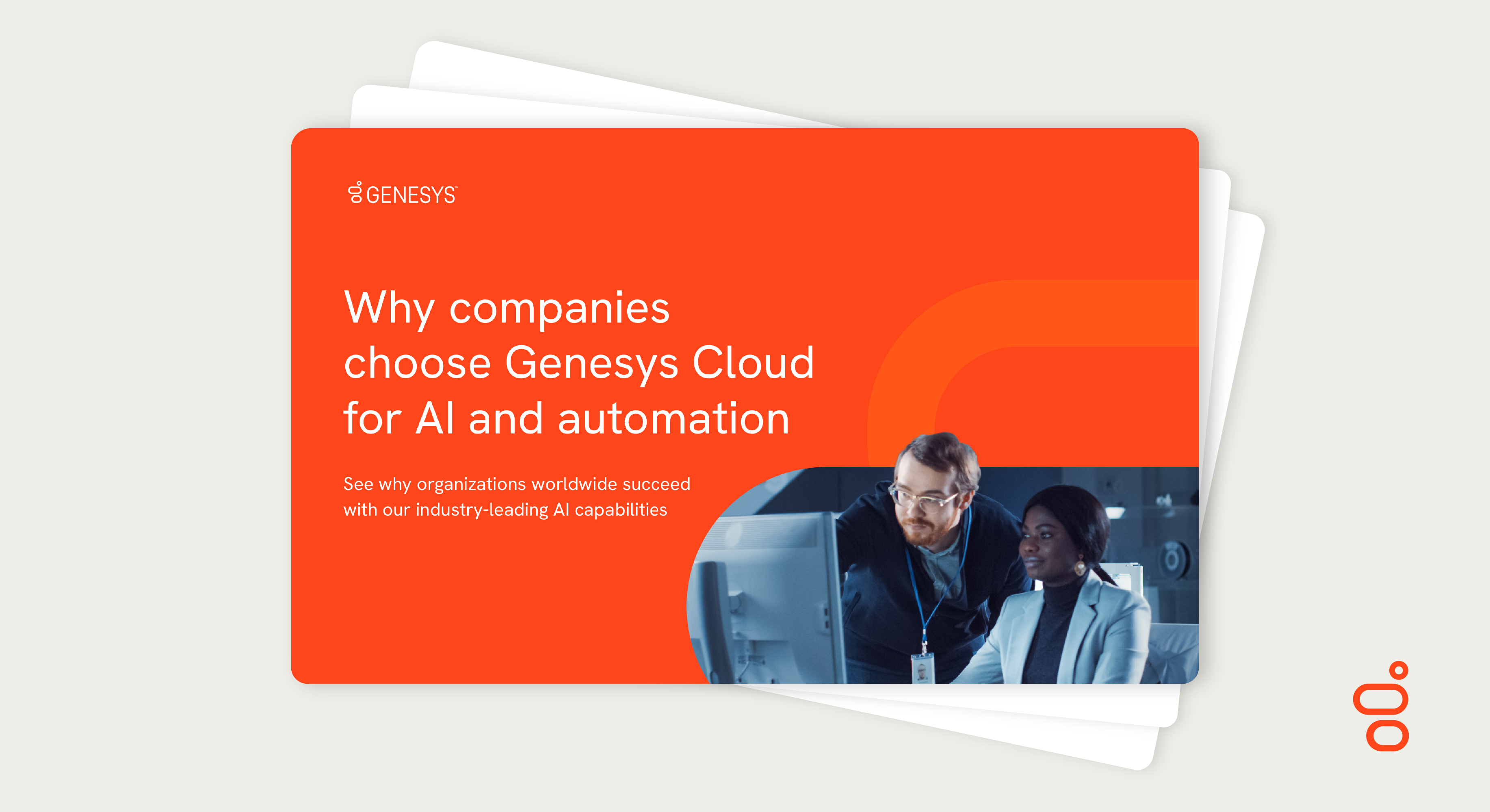Your Genesys Blog Subscription has been confirmed!
Please add genesys@email.genesys.com to your safe sender list to ensure you receive the weekly blog notifications.
Subscribe to our free newsletter and get blog updates in your inbox
Don't Show This Again.

Speech and text analytics have given businesses visibility into customer interactions and agent performance for many years. Now, these capabilities are indispensable for organizations that want to improve the customer experience (CX) across all channels of engagement, including bots. Rapid advancements in artificial intelligence (AI) are going to further the benefits of speech and text analytics.
A Genesys study, “Customer experience in the age of AI,” revealed that 70% of CX leaders surveyed identify AI as crucial to their operations in the next two to three years. With AI-powered advancements, speech and text analytics have become essential tools for enhancing efficiency, driving personalized customer experiences and enabling real-time decision-making.
Speech and text analytics software processes and analyzes large datasets to extract valuable insights from customer interactions, such as recorded calls, bot interactions, email and chat transcripts. These tools harness AI’s capabilities to analyze customer sentiment and agent empathy, identify trends, and pinpoint areas for improvement that enable better decision-making.
At its core, speech and text analytics software empowers organizations by surfacing data that provides a clearer understanding of customer satisfaction, frustration points and roadblocks they’ve hit while trying to get service. It is the foundation of conversational intelligence. Armed with this knowledge, businesses can drive targeted improvements that enhance both customer and employee experiences, at scale.
Modern speech and text analytics software uses AI-driven algorithms that process both voice and digital interactions — and provide transcriptions in real time.
Key components include:
These capabilities are essential for delivering a seamless, efficient and personalized customer experience.
Speech and text analytics offers valuable insights into customer engagement. These enable you to target specific employee and service improvements.
You can uncover specific areas where your products or services might be falling short. For example, if numerous interactions reveal that customers don’t understand recent pricing changes, businesses can proactively address the issue by creating new knowledge articles. These knowledge articles can then power various use cases, such as website self-service, virtual agent conversations, agent training or real-time assistance with agent copilot.
Using topic miner functionality, you can analyze voice and digital transcripts and discover new topics or recurring phrases. This is done at an aggregate level — allowing you quick insight into topics that matter across your entire contact center. This functionality can be used to provide more visibility into gaps and issues that need to be addressed.

By identifying patterns and trends in customer interactions, analytics enables you to streamline workflows, reduce call handling times and improve first-contact resolution rates. You can also use these insights to create targeted training programs for agents, ensuring that they’re equipped to handle common issues more effectively.
With the ability to analyze both real-time and historical data, you can make better informed decisions that boost operational efficiency. For instance, AI-driven recommendations can guide agents during live interactions, improving their performance and delivering a more personalized customer experience. Understanding agent skill gaps can also impact performance through training and coaching to improve service and AI routing decisions.
Back-office data analysts, business analysts, supervisors and administrators can also use speech and text analytics to take action in their lines of business for quality management and assurance and to improve operations.
For example, if a trend emerges showing that customers are frequently confused about a particular product feature, your support teams can refine marketing campaigns or improve product design.
When selecting contact center voice analytics software, choose a solution that supports advanced features capable of changing business outcomes.
Conversational analytics should go beyond just customer sentiment to also understand, detect, measure and score agent empathy across interactions. Empathy models should be trained to look at both sides of the conversation and gauge whether an agent is able to consider the context of the discussion with a customer and formulate a response that communicates an understanding of the customer’s concerns or questions. And models should continuously train and refine the analytics as data continues to come in.
With customer sentiment and agent empathy together, organizations are empowered to operationalize empathy and upskill emotional intelligence across their contact center for stronger customer engagements.
This allows businesses to analyze conversations and take fast action. You can uncover insights before they escalate and even quickly adjust your strategy. Supervisors gain a deeper level of responsiveness. For example, if a compliance issue surfaces, you can correct it and quickly update the data used by human agents and virtual agents, and agent copilots – so that all subsequent interactions follow rules and regulations.
All your customer-facing agents — whether human or digital — become better at their jobs as they’re continually and automatically optimized when new speech and text analytics and insights become available.
Granular reports give you detailed insights into individual agent performance, such as compliance adherence and sentiment. This includes how customers are feeling with that agent, the agent’s response and behavior during the interaction, and whether the problem was resolved. You can use these details to evaluate new agents or to understand how seasoned agents handle tough customer calls — so new agents can replicate that successful approach.
Other features let you pinpoint behavior around a specific topic and track improvements over time to see who is driving conversion on this one topic, or what a specific agent is doing. And are they continuing to improve? You should be able to track that data in real time from a performance standpoint across the contact center, or across queues.
But the big picture is just as important: Let’s say that many customers are telling you they don’t understand a new rate calculation. You can’t see that looking at only one agent’s interactions and the topics that agent is handling. Supervisors and admins need to see it across all your agents to spot trends.
Trending level data might also reveal anomalies, such as compliance breaks. And trend topics can be reported on for one agent only, for all agents, any specific queue or all the queues. They highlight broader patterns, including emerging opportunities for growth.
To maximize the value of contact center speech analytics software, it’s essential that the contact center voice analysis software integrates seamlessly with other systems, including employee performance and workforce management tools. This ensures that insights gained from customer interactions are shared across your organization, which enables more informed decision-making. Native integration also reduces risks by removing data transfer errors and inconsistencies between disparate platforms.
With a unified view of each customer’s interaction journey, you can more easily give them consistent, personalized experiences across all touchpoints. And as you learn from your analytics, you’re learning about the words and phrases your customers use and search on.
Conversational intelligence understands the context of what’s happening in a conversation and makes a real-time response based on that. It does so by combining real-time and post-interaction analytics to fuel real-time intelligence, extending your tools to become far more useful.
The analytics on the back-end influences the AI so that it reads the context and understands the best response. It’s a highly effective way to improve customer experiences as the results are delivered through bots, virtual agents and assistive tools, like agent copilots. These tools need their models trained with data you’ve captured and analyzed.
Let’s look at a simple and common use case. When a customer has an upcoming doctor’s appointment, they might ask which documents to bring to the appointment. If that hasn’t happened before, and you haven’t collected that information and put it in the model, the system won’t know to give customers the right list of documents for that appointment. Yet, with insights from speech and text analytics, you know that other customers have asked that question.
Once that information is identified, you can feed it to the training model. So, the next time a customer asks which documents to bring, the model will surface that information to the agent. This proactive approach enhances the customer experience and reduces the volume of inbound interactions.
Choosing natively built speech and text analytics solutions offers several advantages over third-party integrations. Some of the key benefits include:
Seamless integration: Natively built solutions are designed from the ground up to work seamlessly with other applications, such as agent copilots and virtual agents — reducing the need for customization.
Clean data: With a unified data layer, businesses can eliminate the risk of data inconsistencies that often occur when transferring information between systems, including voice call recordings for interactions. Data used for analysis is accurate and reliable.
Reduced maintenance costs: A single, integrated solution reduces the costs associated with maintaining multiple systems. It simplifies the process of optimizing and updating the analytics software, as there’s no need to manage multiple versions across different platforms.
As businesses adopt more advanced text and speech analytics tools, protecting customer data remains a top priority. Genesys has parameters in place to protect business and customer data as it’s being analyzed. This includes practices such as data masking of sensitive information like credit card numbers and birthdates during the analysis process.
But data traverses many business systems and needs protection at every stage. That need drives our AI ethics approach and protocols. These automatically protect data used by all our products versus data protection designed only for speech and text analytics software.
Genesys trains its embedded models with curated, trusted data across multiple industries, languages, use cases, dimensions and more. With stringent AI ethics guidelines, we incorporate privacy design principles during development. These guardrails protect the individual’s right to privacy from the outset and we don’t do add-ons after development.
Speech and text analytics have evolved into the brain of contact center operations, providing organizations with the insights they need to optimize performance, improve customer support and drive growth. From enhancing agent performance to fueling predictive analytics and enabling proactive customer service, it offers major benefits.
As businesses continue to rely on data to inform decision-making, the importance of natively built, we believe AI-driven speech and text analytics solutions will only grow. By investing in these tools, organizations can ensure that they’re equipped to meet the evolving needs of their customers and stay ahead in an increasingly competitive market.
Ultimately, speech and text analytics tools aren’t just about understanding what customers are saying. Use the knowledge and insights to transform the way you do business, ensuring that every interaction is as effective and efficient as possible.
Read the eBook, “Why Companies Choose Genesys Cloud for AI and Automation” to learn how you can improve service efficiency and personalization.
Subscribe to our free newsletter and get blog updates in your inbox.
Related capabilities: